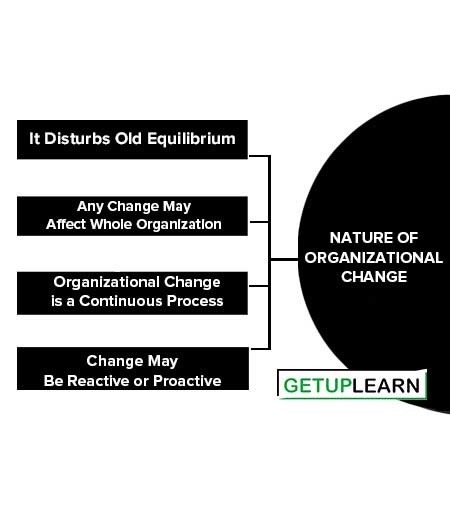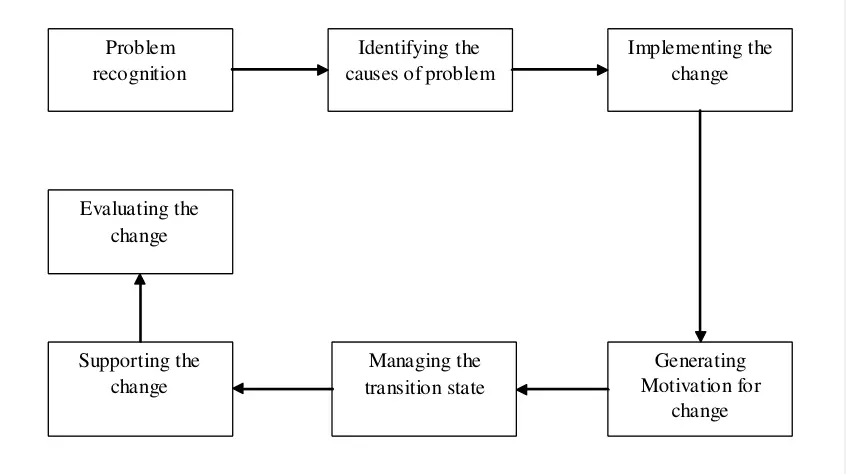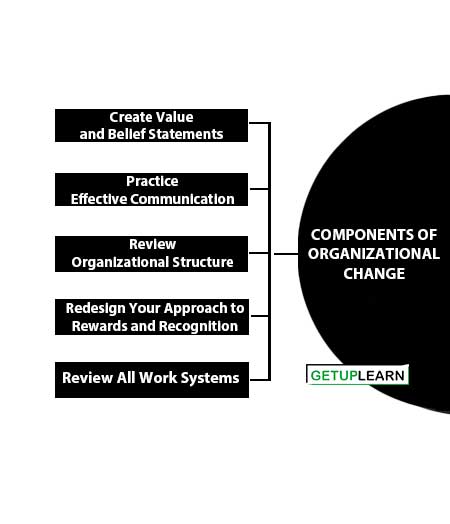Table of Contents
What is Change?
Change refers to any alteration that occurs in the total work environment. Generally, people are accustomed to a well-established way of life and any variation in or deviation from that life may be called a change. Change in some way is a necessary aspect of human life. Change is the law of nature. It is an event that occurs when something passes from one state or phase to another.
What is Organizational Change?
Organizational change refers to a modification or transformation of the organization’s structure, processes, or goods. Organizational change is the process in which an organization changes its structure, strategies, operational methods, technologies, or organizational culture to affect change within the organization and the effects of these changes on the organization. Organizational change can be continuous or occur for distinct periods of time.
Change management refers to three significant areas engineering (a process in systems engineering), organization, and people (an organized approach to change in human beings, teams, groups, organizations, and societies). At its core, the creation of readiness for change involves changing individual cognitions across a set of employees…it is a precursor to either resistance or support for change.”
Definition of Organizational Change
Organizational change is the process by which organizations move from their present state to some desired future state to increase their effectiveness. The goal is to find improved ways of using resources and capabilities in order to increase an organization’s ability to create value.
Getuplearn
Nature of Organizational Change
The term change refers to an alteration in a system whether physical, biological, or social. Thus, organizational change is the alteration of the work environment in the organization. The following is the nature of organizational change:
- It Disturbs Old Equilibrium
- Any Change May Affect Whole Organization
- Organizational Change is a Continuous Process
- Change May Be Reactive or Proactive

It Disturbs Old Equilibrium
When change occurs in any part of the organization, it disturbs the old equilibrium; necessitating the development of a new equilibrium. This equilibrium implies between different components of the organization- technology, structural arrangement, job design, and people. The type of new equilibrium depends on the degree of change and its impact on the organization.
Any Change May Affect Whole Organization
Any change may affect the whole organization; some parts of the organization may be affected more, others less; some parts are affected directly, others indirectly.
Organizational Change is a Continuous Process
Organizational change is a continuous process. However, some changes that are of a minor type may be absorbed by the existing equilibrium; others, which are ones that may require special change efforts.
Change May Be Reactive or Proactive
Change may be reactive or proactive. When change is brought about due to the pressure of external forces, it is reactive change. Proactive change is initiated by the management on its own to increase organizational effectiveness.
Process of Organizational Change
Organizational change is a complex process that involves various stages. These stages must follow a certain sequence. The sequences of stages of the process of organizational change are shown below:
- Problem Recognition
- Identifying Causes of Problems
- Implementing Change
- Generating Motivation for Change
- Managing Transition State
- Supporting Change
- Evaluating Change

Problem Recognition
In the problem recognition stage, management acknowledges that a problem exists in the organization. The data-gathering processes in the organization highlight the problems in the organization, which affect its productivity and thus make the management aware that a problem exists.
Employee turnover, absenteeism, union disputes, employee grievances, high cost of production, role conflicts, and declining profits are some examples of problems that affect the productivity of organizations.
Identifying Causes of Problems
In this stage, management must find out the root cause of those problems that are identified in the problem recognition stage.
For example, if declining profitability is identified as the major problem facing the organization, it could be attributed to reasons such as a decline in employee productivity, an increase in the production of scrap in the manufacturing stages, a reduction in orders from customers, etc.
Implementing Change
After holding discussions with employees and analyzing the feedback gathered through questionnaires, the management will be able to identify the underlying causes of organizational problems. The management must then design a change plan to improve the situation and solve the problems.
Generating Motivation for Change
Three strategies to motivate employees to embrace changes:
- Management should constantly make employees realize the shortcomings in the existing system so that the resulting dissatisfaction will make them welcome the change initiatives in the organization. The management should ensure that the change program does not worsen the situation or fall short of the employees’ expectations.
- Employees should be given a role to play in the change process. Participation promotes a sense of ownership among the employees towards the change process and encourages them to contribute to its success.
- Employees who successfully adopt the designed behavior should be rewarded. This is an effective way of encouraging employees to welcome change
Managing Transition State
The change process disturbs the condition or state of affairs that currently exists in the organization. For example, when an organization adopts an informal culture, job profiles and reporting relationships change, and the old rules and procedures are no longer applicable.
Employees will be in a state of confusion during the transition from the existing system to the new system. They may not know what their new roles are; what new skills are required to perform their new roles, which they should report to, what the new performance criteria are, and so on.
Supporting Change
To implement change successfully, management must obtain the support and co-operation of various employee groups. This can be achieved through negotiation, cooperation, and compromise. Failure to obtain the support of employee groups may result in strong resistance to the change program.
Evaluating Change
After its implementation, the change must be evaluated to check whether the new system has been able to solve the problems identified in the old system and whether the desired future state has been attained.
If the new system fails to solve the problems, or discrepancies are found between the new system and the expected stage, something has clearly gone wrong with the change process. In such a case, all the stages of the change process from the problem diagnosis to the evaluation stage must be repeated once again.
Components of Organizational Change
Organizational culture sets a framework within which individual and group behavior takes place. Organizational culture is the workplace environment formulated from the interaction of the employees in the workplace.
Organizational culture is defined by all of the life experiences, strengths, weaknesses, education, upbringing, and so forth of the employees. While executive leaders play a large role in defining organizational culture by their actions and leadership, all employees contribute to the organizational culture.
The success of any organization depends on its culture, as it is the invisible power governing the organization. Organizational culture is its strong soul which makes its functions possible and lively.
According to O’Reilly, “Organization culture is the set of assumptions, beliefs, values and norms that are shared by an organization’s members.” The important components of organizational change are:
- Create Value and Belief Statements
- Practice Effective Communication
- Review Organizational Structure
- Redesign Your Approach to Rewards and Recognition
- Review All Work Systems

Create Value and Belief Statements
Use employee focus groups, by department, to put the mission, vision, and values into words that state their impact on each employee’s job.
For one job, the employee stated: “I live the value of quality patient care by listening attentively whenever a patient speaks.” This exercise gives all employees a common understanding of the desired culture that actually reflects the actions they must commit to on their jobs.
Practice Effective Communication
keeping all employees informed about the organizational culture change process ensures commitment and success. Telling employees what is expected of them is critical for effective organizational culture change.
Review Organizational Structure
Changing the physical structure of the company to align it with the desired organizational culture may be necessary. As an example, in a small company, four distinct business units competing for products, customers, and internal support resources, may not support the creation of an effective organizational culture. These units are unlikely to align to support the overall success of the business.
Redesign Your Approach to Rewards and Recognition
You will likely need to change the reward system to encourage the behaviors vital to the desired organizational culture.
Review All Work Systems
Review all work systems such as employee promotions, pay practices, performance management, and employee selection to make sure they are aligned with the desired culture. As an example, you cannot just reward individual performance if the requirements of your organizational culture specify teamwork.
An executive’s total bonus cannot reward the accomplishment of his department’s goals without recognizing the importance of playing well with others on the executive team to accomplish his organizational goals.
Barriers to Organizational Change
The need for rapid organizational change is a fact of life in today’s business environment. The key to successful change is in the planning and the implementation. The three greatest barriers to organizational change are most often the following:
- Inadequate Culture-Shift Planning
- Lack of Employee Involvement
- Inconsistent Communication Strategies

Inadequate Culture-Shift Planning
Most companies are good at planning changes in reporting structure, work area placement, job responsibilities, and administrative structure. Organizational charts are commonly revised again and again. Timelines are established, benchmarks are set, transition teams are appointed, etc.
Failure to forecast and plan for resultant cultural change, however, is also common. When the planning team is too narrowly defined or too focused on objective analysis and critical thinking, it becomes too easy to lose sight of the fact that the planned change will affect people.
Even at work, people make many decisions on the basis of feelings and intuition. When the feelings of employees are overlooked, the result is often deep resentment because some unrecognized taboo or tradition has not been duly respected.
Lack of Employee Involvement
People have an intrinsic fear of change. In most strategic organizational changes, at least some employees will be asked to assume different responsibilities or focus on different aspects of their knowledge or skill. The greater the change a person is asked to make, the more pervasive that person’s fear will be.
There will be fear of change. More important, however, there will be fear of failure in the new role. Involving employees as soon as possible in the change effort, and letting them create as much of the change as is possible and practical is key to a successful change effort.
As employees understand the reasons for the change and have an opportunity to “try the change on for size” they more readily accept and support the change.
Inconsistent Communication Strategies
Ideal communication strategies in situations of significant organizational change must share a clear message, the method of delivery, the timing, and the importance of information shared with various parts of the organization.
Many leaders believe that if they tell people what they (the leaders) feel they need to know about the change, then everyone will be on board and ready to move forward. In reality, people need to understand why the change is being made, but more importantly, how the change is likely to affect them.
A big-picture announcement from the CEO does little to help people understand and accept change. People want to hear about change from their direct supervisor. A strategy of engaging direct supervision and allowing them to manage the communication process is the key to a successful change communication plan.
FAQs About the Organizational Change
What is the process of organizational change?
These are the 7 stages of the process of organizational change:
1. Problem Recognition
2. Identifying Causes of Problems
3. Implementing Change
4. Generating Motivation for Change
5. Managing Transition State
6. Supporting Change
7. Evaluating Change.
